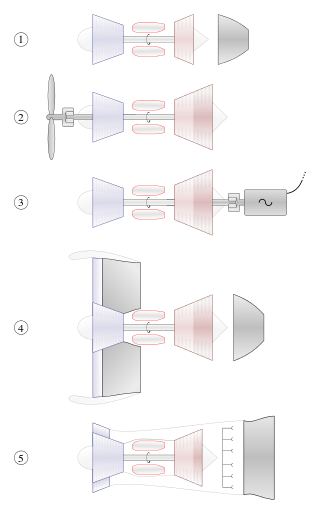
A gas turbine, gas turbine engine, or also known by its old name internal combustion turbine, is a type of continuous flow internal combustion engine. The main parts common to all gas turbine engines form the power-producing part and are, in the direction of flow:

General Electric Company, doing business as GE Aerospace, is an American aircraft engine supplier that is headquartered in Evendale, Ohio, outside Cincinnati. It is the legal successor to the original General Electric Company founded in 1892, which split into three separate companies between November 2021 and April 2024, adopting the trade name GE Aerospace after divesting its healthcare and energy divisions.

The General Electric TF39 is a high-bypass turbofan engine that was developed to power the Lockheed C-5 Galaxy. The TF39 was the first high-power, high-bypass jet engine developed. The TF39 was further developed into the CF6 series of engines, and formed the basis of the LM2500 and LM6000 marine and industrial gas turbine. On September 7, 2017, the last active C-5A powered with TF39 engines made its final flight to Davis-Monthan Air Force Base for retirement. The TF39 was effectively retired, and all remaining active C-5 Galaxys are now powered by F138 engines.

IHI Corporation, formerly known as Ishikawajima-Harima Heavy Industries Co., Ltd. is a Japanese engineering corporation headquartered in Tokyo, Japan that produces and offers ships, space launch vehicles, aircraft engines, marine diesel engines, gas turbines, gas engines, railway systems, turbochargers for automobiles, plant engineering, industrial machinery, power station boilers and other facilities, suspension bridges and other structures.

Combined diesel and gas (CODAG) is a type of propulsion system for ships that need a maximum speed that is considerably faster than their cruise speed, particularly warships like modern frigates or corvettes.

The General Electric LM6000 is a turboshaft aeroderivative gas turbine engine. The LM6000 is derived from the CF6-80C2 aircraft turbofan. It has additions and modifications designed to make it more suitable for marine propulsion, industrial power generation, and marine power generation use. These include an expanded turbine section to convert thrust into shaft power, supports and struts for mounting on a steel or concrete deck, and reworked controls packages for power generation. It has found wide use including peaking power plants, fast ferries and high speed cargo ship applications.

The General Electric CF6, US military designations F103 and F138, is a family of high-bypass turbofan engines produced by GE Aviation. Based on the TF39, the first high-power high-bypass jet engine, the CF6 powers a wide variety of civilian airliners. The basic engine core also powers the LM2500 and LM6000 marine and power generation turboshafts. It is gradually being replaced by the newer GEnx family.

HMS Exmouth was a Royal Navy anti-submarine warfare frigate of the Blackwood or Type 14 class.
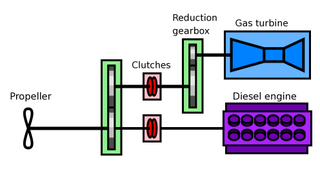
Combined diesel or gas (CODOG) is a type of propulsion system for ships that need a maximum speed that is considerably faster than their cruise speed, particularly warships like modern frigates or corvettes.
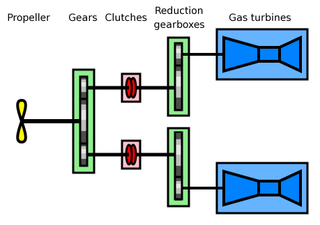
Combined gas turbine and gas turbine (COGAG) is a type of propulsion system for ships using two gas turbines connected to a single propeller shaft. A gearbox and clutches allow either of the turbines to drive the shaft or both of them combined. Marine usage of COGAG systems are similar to those found ashore.
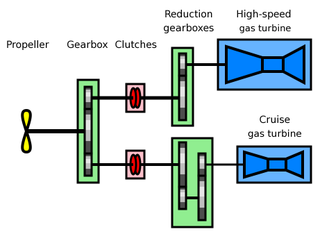
Combined gas or gas (COGOG) is a propulsion system for ships using gas turbine engines.

Combined diesel-electric and gas (CODLAG) is a modification of the combined diesel and gas propulsion system for ships. A variant, called the combined diesel-electric or gas (CODLOG) system, contains the same basic elements but will not allow simultaneous use of the alternative drive sources.
The Rolls-Royce MT30 is a marine gas turbine engine based on the Rolls-Royce Trent 800 aero engine. The MT30 retains 80% commonality with the Trent 800, the engine for the Boeing 777. The maximum power rating is 40 MW and minimum efficient power 25 MW.

The General Electric LMS100 is an aero derivative gas turbine produced by GE Distributed Power.
The General Electric LM500 is an industrial and marine gas turbine produced by GE Aviation. The LM500 is a derivative of the General Electric TF34 aircraft engine. Current versions of the LM500 deliver 6,000 shaft horsepower with a thermal efficiency of 31 percent at ISO conditions. It has been used in various applications such as in the Royal Danish Navy's Flyvefisken class patrol vessels, and in fast ferries.
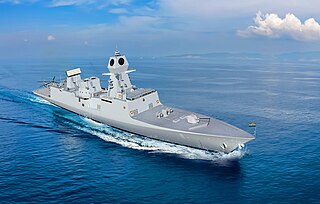
The Nilgiri-class frigates, formally classified as the Project-17 Alpha frigates (P-17A), are a series of stealth guided-missile frigates currently being built by Mazagon Dock Shipbuilders (MDL) and Garden Reach Shipbuilders & Engineers (GRSE), for the Indian Navy. The seventh and final ship of the Project 17A frigates, named Mahendragiri, was launched on 1 September 2023 at the Mazagon Dock by Dr Sudesh Dhankhar, wife of Indian vice-president Jagdeep Dhankhar. It is expected to be commissioned in 2024.
The General Electric LM1600 is an industrial and marine gas turbine produced by GE Aviation. The LM1600 is a derivative of the General Electric F404 aircraft engine series. The LM1600 delivers 20,000 shaft horsepower (shp) (14,920 kW) with a thermal efficiency of 37 percent at ISO conditions.

Integrated electric propulsion (IEP), full electric propulsion (FEP) or integrated full electric propulsion (IFEP) is an arrangement of marine propulsion systems such that gas turbines or diesel generators or both generate three-phase electricity which is then used to power electric motors turning either propellers or waterjet impellors. It is a modification of the combined diesel-electric and gas propulsion system for ships which eliminates the need for clutches and reduces or eliminates the need for gearboxes by using electrical transmission rather than mechanical transmission of energy, so it is a series hybrid electric propulsion, instead of parallel.

The Rolls-Royce Marine Olympus is a marine gas turbine based on the Rolls-Royce Olympus aircraft turbojet engine.

















